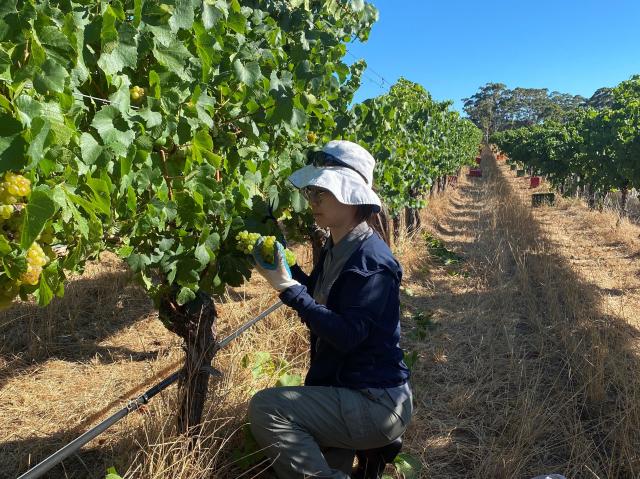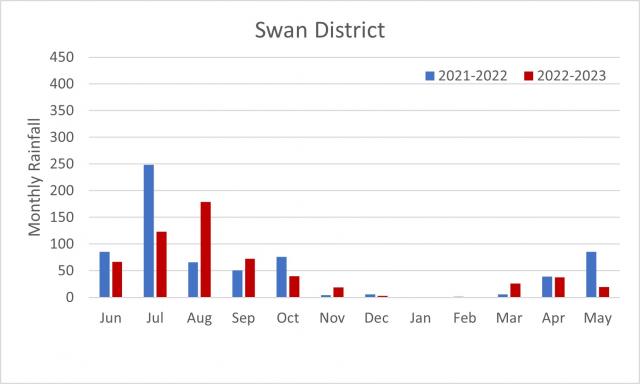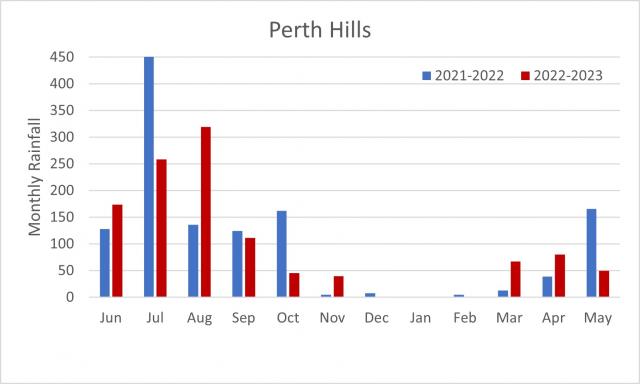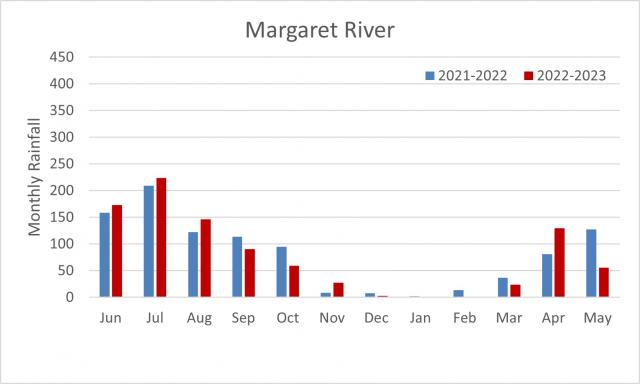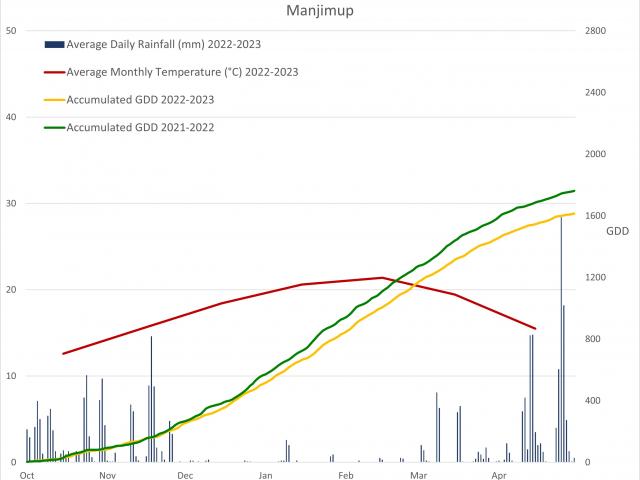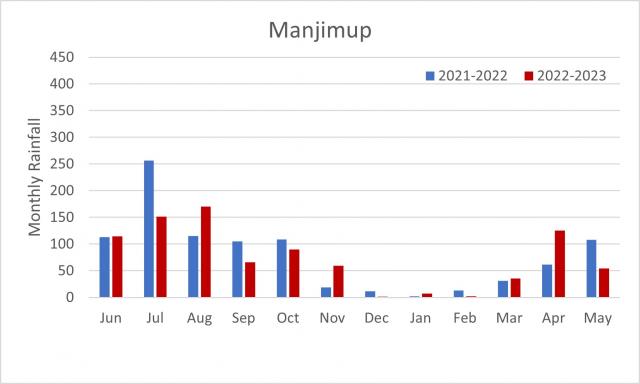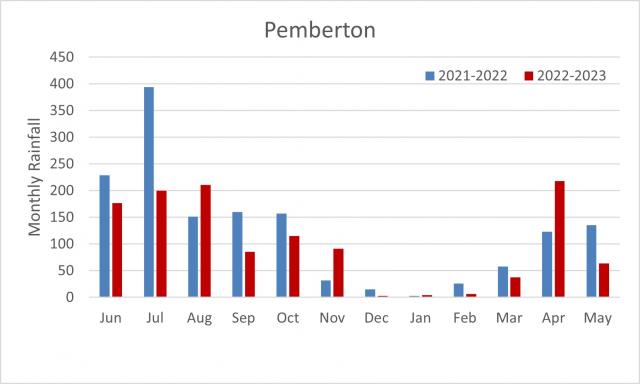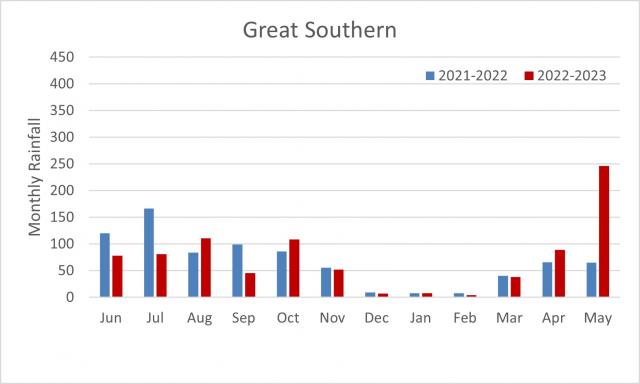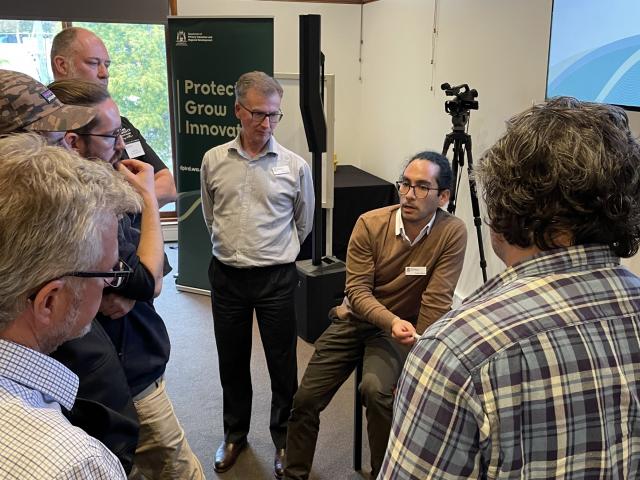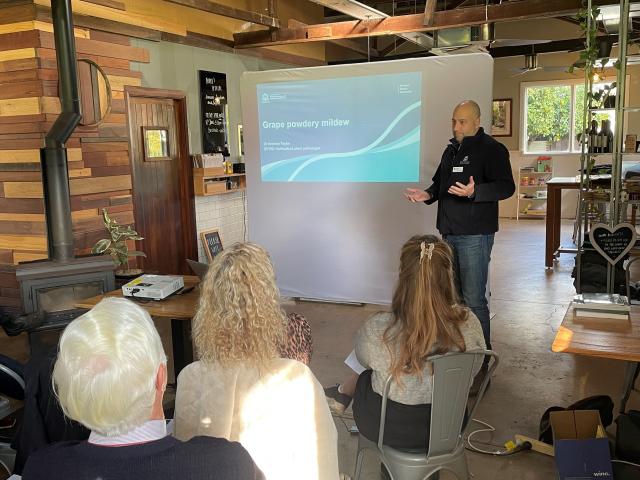Electric weed control: a new weed management option
The Department of Primary Industries and Regional Development (DPIRD) has commenced an Australian-first project to determine the best fit for electric weed control with AGXTEND, a brand of CNH Industrial.
Electric weed control (or electro-weeding) offers an alternative non-selective weed control method to reduce current chemical use and can be used across a variety of industries, including viticulture, horticulture, orchards and for urban/industrial weed management.
Trials completed in the Margaret River wine region in 2022 found that electric weed control efficiency was comparable to herbicide use of glyphosate (Crucial®) and amitrole with ammonium thiocyanate (Amitrole T), and greater than mowing (simulating grazing), regardless of power output (24 or 36 kW). Electric weed control killed weeds that came into direct contact with the electrodes, but left a swath of weeds under the vine strip where the electrodes could not reach.
These applications occurred on dense and mature grass weeds and conditions were suboptimal for achieving an effective electric weed control application due to wet weeds and topsoil. Manufacturer recommendations indicate optimal control when treating dry weeds with low topsoil moisture content. The trials also showed no evidence of damage to vines following the applications with NDVI assessment indicating no difference in vine growth between treatments.
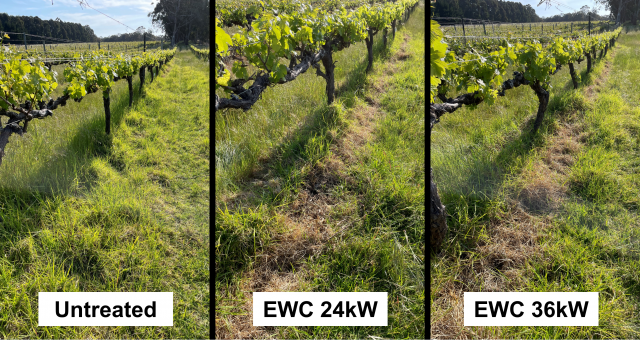
DPIRD is using the electric weed control machinery XPower, powered by the company Zasso™' in these trials. This technology is already utilised across Europe and DPIRD is seeking to prove the concept of its applicability in Australian systems with the hope it will be certified for use here in the coming years.
For applications in viticulture and orchards, the XPS applicator is used with the XPower and is designed to control the 55cm of weeds adjacent to a row of vines (or trees) and has a swinging ‘intercept’ arm, designed to control weeds directly underneath the vines. When this machinery is used in Europe it commonly has a 24 kW power unit. However, the machine currently being tested in Australia is 36 kW, and so the efficacy of the two different application rates is also being compared.
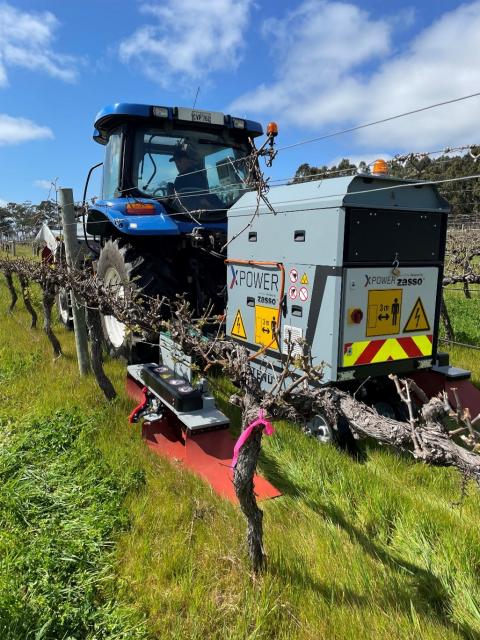
The technology works through the conversion of the tractor’s power take off (PTO) power into a high voltage current in the rear power unit which is transferred to the applicator unit containing electrodes. As the tractor moves forward, these electrodes touch the plants and transfer the current through their shoots and roots. The current transforms to heat energy and bursts the plant’s cells, killing it or suppressing growth, with effects visible instantly. The current then goes into the soil and a second row of electrodes of the opposite charge pull the current back up, closing the circuit.

DPIRD will continue to test this new technology in viticulture, with trials to be replicated in the Margaret River region this year. The project will also complete a range of other industry trials across the state with funding from the Grains Research and Development Corporation (GRDC), Wine Australia, AHA Viticulture and the Cotton Research and Development Corporation (CRDC).
For more information on this project, please contact Miranda Slaven or Catherine Borger.
Harvest completed for research projects
The DPIRD wine research team consisting of Richard Fennessy and Yu-Yi Liao have completed another successful vintage period of harvesting numerous trial sites, collecting data and making small-lot wines.
The first pick was made on 16 February and the last on 17 April 2023. During this two month period the team travelled 8600km collecting maturity samples and picking various vineyard sites.
This season saw a continuation of the projects undertaken in the previous season being: Understanding the intricacies of provenance in Western Australian wine regions and Demonstrating how clonal selection can influence Cabernet Sauvignon wine quality.
The provenance project is the second consecutive vintage where the DPIRD team have harvested Chardonnay and Cabernet sites within the Margaret River region and Riesling and Shiraz from the Great Southern. Within these two wine regions 58 separate vineyard sites were harvested. Using a standardised small-lot winemaking procedure these wines will undergo sensory and chemical analysis to determine if linkages between elements of site can be attributed to wine attributes.
For the third consecutive year a trial block of 14 different clones and selections of Cabernet Sauvignon were harvested from this Margaret River site. The parcels were harvested over three dates: 6, 11 and 14 April 2023. The last picking day was a forced decision as the site received 20mm of rainfall that day and the forecast indicated further significant rain in the coming days.
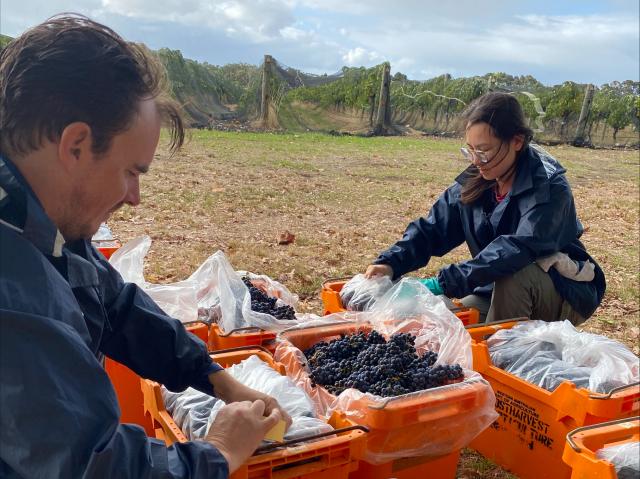
With hindsight some of the parcels could have stayed on the vine to further ripen to the desired sugar specification but the information available at the time suggested the contrary. Just under 500kg of fruit was picked across the 14 clones and selections.
In total, the team picked 72 separate parcels across the two wine regions which comprised 1400kg of fruit and approximately 150 separate ferments. The wines are currently undergoing cold stabilisation and will be bottled in August 2023.
Acknowledgements
Funding for the Provenance project is received via the Wine Export Growth Partnership of which Wines of WA is a partner. The Cabernet clone activity is funded via the Wine Australia Regional Program (administered by Wines of WA).
Climate data for 2023 vintage
Following the previous newsletter article ‘A comparison of seasons’, a complete data set of the 2022-23 growing season is presented below. The graphs illustrate the climatic conditions which has typified the recent growing season and makes comparison to the previous season for each of WA's 9 wine regions.
The data displayed was accessed via DPIRD’s weather station and radar webpage and the Bureau of Meteorology (BoM).
Swan District
Figure 1 and 2 show data collected from the BoM Millendon weather station (site number 9281) representing the Swan District wine region. The data shows 2022-23 was a cooler season compared to 2021-22 and that winter rainfall patterns differed between the seasons, largest falls in 2021 occurred in July whereas in 2022, August was the wettest month.
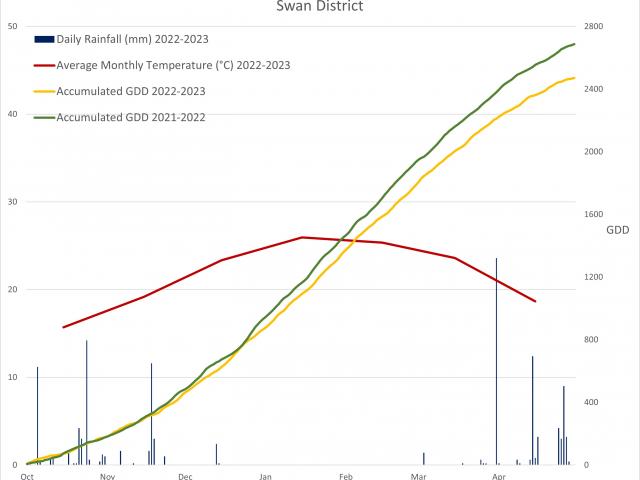
Perth Hills
Two stations were used to represent the Perth Hills, BoM station Bickley (site number 9240) and DPIRD station Glen Eagle in Figure 3 and 4. The Perth Hills experienced similar winter rainfall trends across the two seasons as the Swan Valley. The total rainfall in March and April 2023 was almost 3 times of that which fell during the same period in 2022.
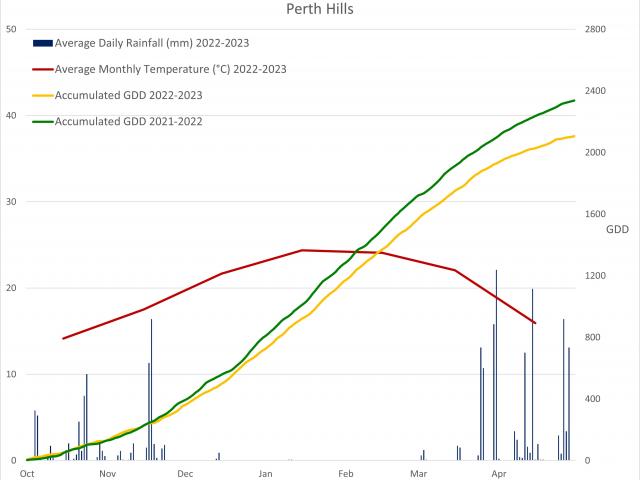
Peel
Peel’s data in Figure 5 and 6 is sourced from BoM Dwellingup weather station (site number 9538). Data from the previous 2 seasons follow similar trends to those described for Swan Valley and Perth Hills.
Geographe
DPIRD’s weather stations' Capel, Donnybrook and Dardanup 2 were compiled to represent Geographe in Figure 7 and 8. The 2022-23 season was slightly cooler than the 2021-22 season, while rainfall was similar.
Margaret River
Figure 9 and 10 illustrates Margaret River’s seasonal data from DPIRD’s Vasse, Wilyabrup, Margaret River, Rosa Brook and Karridale weather stations. The 2022-23 season was around 150 GDD units cooler than the previous season. Similar rainfall patterns were experienced across the 2 seasons, but April 2023 received approximately 50mm more than April 2022.
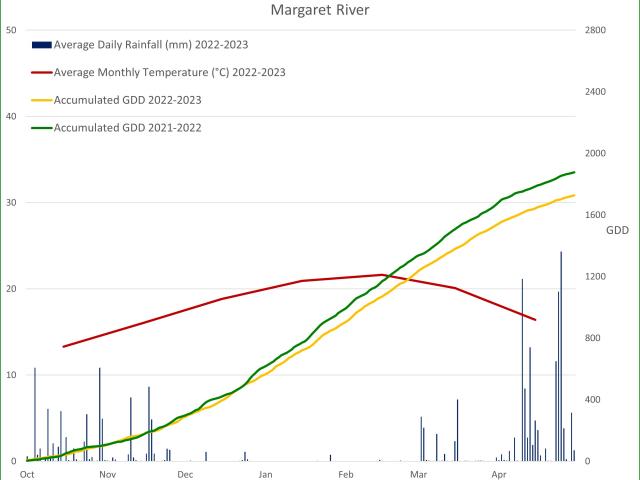
Blackwood Valley
Data derived from BoM Bridgetown weather station (number 9617), DBCA station Styles Tower and DPIRD station Nannup are illustrated in Figure 11 and 12. GDD was mirrored in both seasons and around double the amount of rain fell in April 2023 (72mm) compared to 2022.
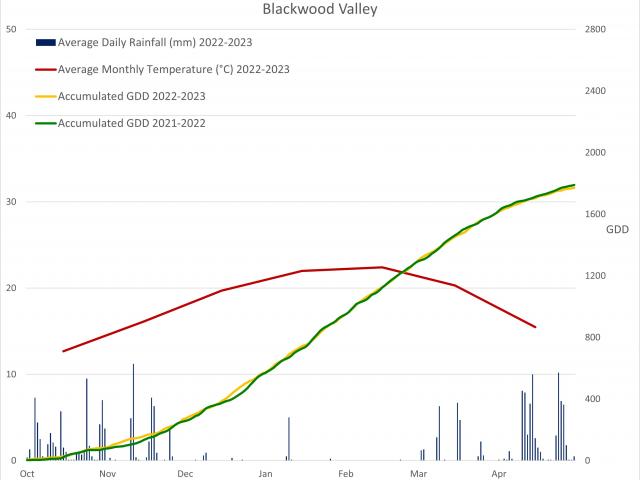
Manjimup
The BoM weather station at Manjimup (site number 9573) and DPIRD’s Manjimup HRS station provided data to represent Manjimup's growing season in Figure 13 and 14. The GDD data shows 2022-23 season was cooler than the previous season, but similar to Blackwood Valley. Rainfall in April 2023 (126mm) was double that of 2022.
Pemberton
The DPIRD Pemberton weather station was the only station used in Figures 15 and 16. The data shows similar trends as those described for Manjimup, noting significant rainfall events on 13 (35mm), 23 (24mm), 24 (48mm) and 25 (54mm) April 2023.

Great Southern
Weather stations from the subregions of the Great Southern were combined to produce Figures 17 and 18. Stations used were BoM's Albany Airport (9741) and Rocky Gully Town (9661), Water Corporation's Quickup Dam and DPIRD's Denmark, Mt Barker, Stirlings South, Frankland North and Frankland weather stations.
Of all the wine regions, Great Southern had the largest difference in GDD across the 2 growing seasons, with 2022-23 being 222 GDD units cooler than the previous season. It is also clear from Figure 18 that May 2023 received significant and consistent rainfall, averaging 8mm each day in May.
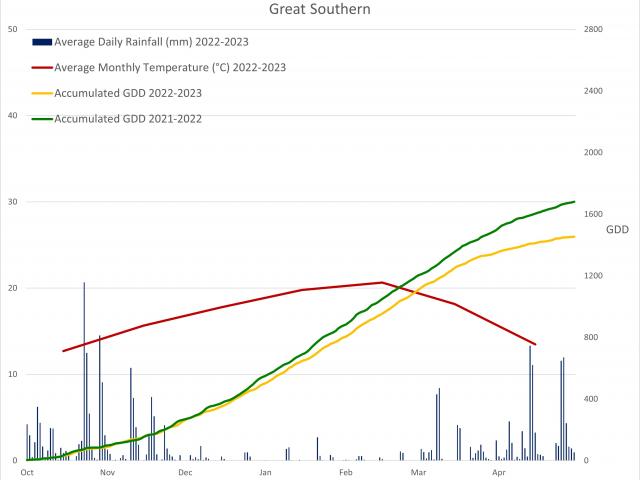
For more information on these climate summaries, contact Yu-Yi Liao.
Digital innovations offer value to the wine industry
In WA’s high cost of business economy, business process automation offers one of the few levers for cost control, efficiency gains and maintaining margins. Automated work process solutions may cost only a few hundred dollars per solution to install but can provide a quick and substantial return on investment.
Seven wine businesses recently participated in a workshop to identify digitalisation priorities for the Margaret River wine region as part of an industry pilot of the Shoestring program.
The Shoestring program is a step-by-step approach to digitalisation that uses off-the shelf, readily available technologies to create low-cost, low-risk digital solutions. The program is supported by the University of Cambridge (UK) and backed by a four-year commitment by the Western Australian government.
At the pilot workshop held in May, participants reviewed a catalogue of 29 low-cost digital solutions tailored to the needs of the Margaret River wine industry.
There were several strong themes identified and the Shoestring team will now work with participating wine businesses to help tailor and implement solutions to suit their specific needs, using a collaborative approach.
If you are interested in finding out more, please register your interest in the Shoestring program by completing the web form accessible via the QR code below:

DPIRD delivers pruning and disease workshop to Perth Hills
Earlier this month DPIRD research scientists Richard Fennessy and Dr Andrew Taylor presented a workshop to 20 Perth Hills' vignerons on pruning techniques and powdery mildew management.
The first part of the workshop focused on pruning, featuring the foundations of the two most common forms of pruning ‘cane’ and ‘spur’. The 2 methods were compared in terms of evenness of vegetative growth, fruitfulness, productivity, cost and training requirements.
In addition to the conventional practices of these pruning methods, the principles of respecting vine sap flow and accounting for natural wound responds were discussed and how these can be incorporated into pruning decision-making.
The presentation was concluded by noting how vine longevity can be supported by ensuring appropriate wound care at pruning, providing good disease management over the growing season so to support healthy and resilient grapevines.
Dr Andrew Taylor provided the group with insights into the most prevalent fungal disease in viticulture in WA, powdery mildew. The presentation featured an explanation into the asexual and sexual life cycle of the disease under WA conditions.
Further information included details of optimal growing conditions of the fungus, vineyard management strategies and issues associated with fungicide resistance.
The workshop concluded with a walk through the estate’s vineyard to demonstrate some of the learnings covered in the presentations.

The presenters would like to thank the Perth Hills Vignerons Association for the invitation to present and The Packing Shed @ LawnBrook for hosting the event.
Industry biosecurity advice: Phomopsis cane and leaf spot detection in Manjimup
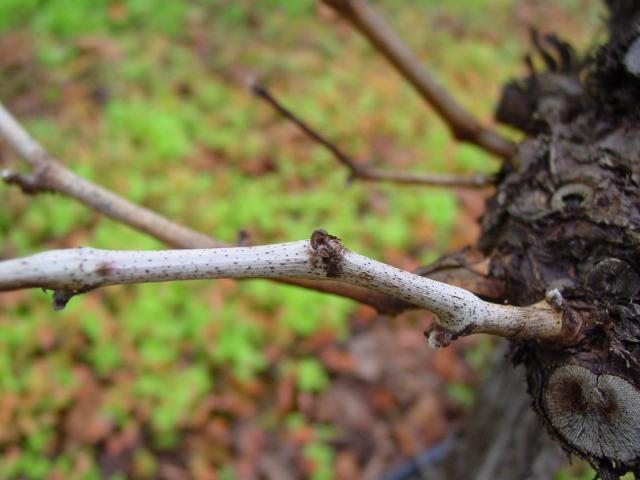
About Phomopsis cane and leaf spot
The disease is caused by the fungus Diaporthe ampelina (formerly Phomopsis viticola). It can affect all parts of the vine, including leaves, shoots and occasionally bunches. Primary infection occurs in spring, where cool and wet conditions, with prolonged leaf wetness increases the incidence and severity of symptoms.
View further symptom development information.
Phomopsis cane and leaf spot is present in all other Australian grape-growing regions and can cause crop loss in areas where weather conditions are favourable and the disease is not effectively controlled. The disease may be managed by monitoring and timely fungicide applications.
Spores are dispersed by water, wind and rain splash in a relatively localised area within a vineyard. Long distance dispersal occurs through movement of infected or contaminated propagation materials and fruit bunches.
All grapevine varieties grown in WA can be infected but differ in their susceptibility.
Under WA’s Biosecurity and Agriculture Management Act 2007, D. ampelina is declared a prohibited organism and subject to movement restrictions, mandatory reporting and control treatments to destroy, prevent or eradicate the pest.
Current situation
Diaporthe ampelina was detected in two grapevine varieties (Sunmuscat and Carina) in the grapevine germplasm collection at the Manjimup Horticultural Research Institute (MHRI).
A Pest Control Notice (PCN) is in place at MHRI to limit the movement of personnel and grapevine material, while the department investigates the extent of the detection at the research station. Further testing of varieties in the germplasm collection for the presence of D. ampelina, is being undertaken.
Unfortunately, this means that grapevine propagation material will not be available this season and until the Pest Control Notice is removed. The department is working with the WA wine and table grape industries regarding the detection and future actions.
As the disease is established in other parts of Australia, an incident response would not be managed or funded under Australia’s national cost-sharing arrangements (Emergency Plant Pest Response Deed) including access to owner reimbursement costs.
Surveillance and reporting
The department will work with the WA wine and table grape industries to develop a targeted spring surveillance program around the Pemberton and Manjimup regions to appropriately inform the next steps regarding feasibility for eradication or changing the status of the presence of D. ampelina in WA.
In the meantime, table and wine grape growers and consultants are encouraged to inspect vines for disease symptoms and report any suspect observations to the department. It's recommended to inspect whole blocks, as the disease spreads slowly from isolated infection sites within vineyards.
Reports of suspected Phomopsis cane and leaf spot can be made to DPIRD’s Pest and Disease Information Service on (08) 9368 3080 or email padis@dpird.wa.gov.au
Alternatively send photos via the Department’s MyPestGuide® Reporter app (Google Play Store and Apple iTunes Store).
Further information
For further information, please contact your local industry representative or Andrew Taylor via email andrew.taylor@dpird.wa.gov.au
Issued by
Chief Plant Biosecurity Officer
Department of Primary Industries and Regional Development, Western Australia
Future events
Cabernet clone tasting
DPIRD Research Scientist Richard Fennessy will be delivering workshop tastings featuring 13 Cabernet Sauvignon clones and selections. These wines from the 2022 vintage were produced from a single trial block planted in Margaret River using a standardised small-lot winemaking procedure. Viticultural data such as key phenological stages, yield, bunch and berry weights were collected over the growing season will also be presented at the tasting.
This tasting provides growers and winemakers with a unique opportunity to explore the flavour spectrum and tannin profile of a number different Cabernet Sauvignon clones and selections sourced from a single block harvested at similar maturities.
When: Wednesday 5 July, 3pm to 5pm
Where: Swan Valley
Further details and registration: Trybooking.
ASVO half day viticulture seminars
Maintaining Established vineyards
Maintaining the long-term vine health, productivity and economic viability of vineyards. Comparing vine age performance, vine age & economic viability, old irrigation infrastructure and replacements.
When: Friday 21 July 2023
Further details and registration: ASVO website
Establishing new vineyards
Establishing data friendly vineyards, irrigation design for better water management, automation,optimising early vine growth, nutrition and weed control.
When: Friday 4 August 2023
Further details and registration: ASVO website
AWRI webinar program
Practical steps to counter increasing fungicide resistance
When: 9.30am, Thursday 13 July 2023
Further details and registration: AWRI website.
Malolactic fermentation - opportunities and limitations
When: 9.30am, Thursday 20 July 2023
Further details and registration: AWRI website.
Update on the National Germplasm Collection
When: 9.30am, Thursday 27 July 2023
Further details and registration: AWRI website.
Overview of the 2023 National Vintage Report
When: 9.30am, Thursday 3 August 2023
Further details and registration: AWRI website.
Soil health, carbon and undervine management in a dry climate
When: 9.30am, Thursday 10 August 2023
Further details and registration: AWRI website.
Greenhouse gas emissions and more - digging about in Sustainable Winegrowing Australia data
When: 9.30am, Thursday 17 August 2023
Further details and registration: AWRI website.

